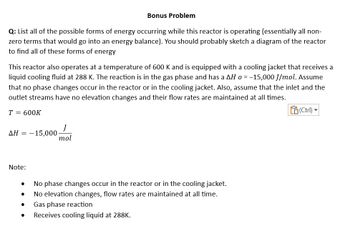A reaction is to be carried out isothermally in a continuous flow reactor. The entering volumetric flow rate = 10 dm^3/hour. The feed molar flow rate FAO = 6 mol/hour. (a) -rA = k (b)-rA = k*CA (c)-rA = k*CA² AB with k = 0.040 mol/(hr* dm^3) with k = 0.00012 sec¹ with k = 320 dm^3/(mol*hr) Use the reaction information and k-values from Problem Three, parts (a) through (c), to calculate the time required to consume 96% of species A in a 1200 dm^3 constant volume batch reactor with a CÃO = 0.6 mol/dm^3
A reaction is to be carried out isothermally in a continuous flow reactor. The entering volumetric flow rate = 10 dm^3/hour. The feed molar flow rate FAO = 6 mol/hour. (a) -rA = k (b)-rA = k*CA (c)-rA = k*CA² AB with k = 0.040 mol/(hr* dm^3) with k = 0.00012 sec¹ with k = 320 dm^3/(mol*hr) Use the reaction information and k-values from Problem Three, parts (a) through (c), to calculate the time required to consume 96% of species A in a 1200 dm^3 constant volume batch reactor with a CÃO = 0.6 mol/dm^3
Introduction to Chemical Engineering Thermodynamics
8th Edition
ISBN:9781259696527
Author:J.M. Smith Termodinamica en ingenieria quimica, Hendrick C Van Ness, Michael Abbott, Mark Swihart
Publisher:J.M. Smith Termodinamica en ingenieria quimica, Hendrick C Van Ness, Michael Abbott, Mark Swihart
Chapter1: Introduction
Section: Chapter Questions
Problem 1.1P
Related questions
Question
100%
1

Transcribed Image Text:A reaction
AB
is to be carried out isothermally in a continuous flow reactor. The entering volumetric flow rate v = 10
dm^3/hour. The feed molar flow rate FAO = 6 mol/hour.
(a) -rA = k
(b)-ra= k*CA
(c)-rA = k*CA²
with k = 0.040 mol/(hr* dm^3)
with k = 0.00012 sec¹
with k = 320 dm^3/(mol*hr)
Use the reaction information and k-values from Problem Three, parts (a) through (c), to calculate the
time required to consume 96% of species A in a 1200 dm^3 constant volume batch reactor with a CAO =
0.6 mol/dm^3
Expert Solution
This question has been solved!
Explore an expertly crafted, step-by-step solution for a thorough understanding of key concepts.
This is a popular solution!
Trending now
This is a popular solution!
Step by step
Solved in 5 steps with 7 images

Follow-up Questions
Read through expert solutions to related follow-up questions below.
Follow-up Question
can you plz help with this followup question

Transcribed Image Text:Bonus Problem
Q: List all of the possible forms of energy occurring while this reactor is operating (essentially all non-
zero terms that would go into an energy balance). You should probably sketch a diagram of the reactor
to find all of these forms of energy
This reactor also operates at a temperature of 600 K and is equipped with a cooling jacket that receives a
liquid cooling fluid at 288 K. The reaction is in the gas phase and has a AH o = -15,000 J/mol. Assume
that no phase changes occur in the reactor or in the cooling jacket. Also, assume that the inlet and the
outlet streams have no elevation changes and their flow rates are maintained at all times.
T = 600K
ΔΗ = -15,000.
Note:
●
●
J
mol
●
No phase changes occur in the reactor or in the cooling jacket.
No elevation changes, flow rates are maintained at all time.
Gas phase reaction
Receives cooling liquid at 288K.
(Ctrl)
Solution
Follow-up Question
operating conditions are what you just solved for:
CAO=0.6
V=1200dm3
plz help me find energy forms

Transcribed Image Text:Consider the PFR from Problem 3 operating under the conditions of Part (b). This reactor also operates
at a temperature of 600 K and is equipped with a cooling jacket that receives a liquid cooling fluid at 28
K. The reaction is in the gas phase and has a AH° = -15,000 J/mol. Assume that no phase changes
occur in the reactor or in the cooling jacket. Also, assume that the inlet and the outlet streams have no
elevation changes and their flow rates are maintained at all times.
List all of the possible forms of energy occurring while this reactor is operating (essentially all non-zero
terms that would go into an energy balance). You should probably sketch a diagram of the reactor to
find all of these forms of energy.
Solution
Recommended textbooks for you

Introduction to Chemical Engineering Thermodynami…
Chemical Engineering
ISBN:
9781259696527
Author:
J.M. Smith Termodinamica en ingenieria quimica, Hendrick C Van Ness, Michael Abbott, Mark Swihart
Publisher:
McGraw-Hill Education

Elementary Principles of Chemical Processes, Bind…
Chemical Engineering
ISBN:
9781118431221
Author:
Richard M. Felder, Ronald W. Rousseau, Lisa G. Bullard
Publisher:
WILEY

Elements of Chemical Reaction Engineering (5th Ed…
Chemical Engineering
ISBN:
9780133887518
Author:
H. Scott Fogler
Publisher:
Prentice Hall

Introduction to Chemical Engineering Thermodynami…
Chemical Engineering
ISBN:
9781259696527
Author:
J.M. Smith Termodinamica en ingenieria quimica, Hendrick C Van Ness, Michael Abbott, Mark Swihart
Publisher:
McGraw-Hill Education

Elementary Principles of Chemical Processes, Bind…
Chemical Engineering
ISBN:
9781118431221
Author:
Richard M. Felder, Ronald W. Rousseau, Lisa G. Bullard
Publisher:
WILEY

Elements of Chemical Reaction Engineering (5th Ed…
Chemical Engineering
ISBN:
9780133887518
Author:
H. Scott Fogler
Publisher:
Prentice Hall


Industrial Plastics: Theory and Applications
Chemical Engineering
ISBN:
9781285061238
Author:
Lokensgard, Erik
Publisher:
Delmar Cengage Learning

Unit Operations of Chemical Engineering
Chemical Engineering
ISBN:
9780072848236
Author:
Warren McCabe, Julian C. Smith, Peter Harriott
Publisher:
McGraw-Hill Companies, The